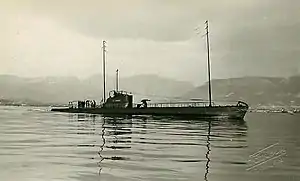French submarine Perle (1935)
Perle was a Saphir-class submarine built for the French Navy in the mid-1930s. Laid down in 1931, she was launched in July 1935 and commissioned in March 1937. In November 1942, after Operation Torch, Perle joined the Allied fleet. While returning from refitting in the United States, Perle was mistaken for a U-boat by Allied aircraft and sunk.
 Sister ship Diamant, date unknown | |
| History | |
|---|---|
| Name: | Perle |
| Namesake: | Pearl |
| Builder: | Arsenal de Toulon |
| Laid down: | 1931 |
| Launched: | 30 July 1935 |
| Commissioned: | 1 March 1937 |
| Fate: | Sunk in error by a Allied aircraft after being mistaken for a U-boat on 8 July 1944 & sunk whive all crew |
| General characteristics | |
| Class and type: | Saphir-class submarine |
| Displacement: | |
| Length: | 66 m (216 ft 6 in) |
| Beam: | 7.2 m (23 ft 7 in) |
| Draught: | 4.3 m (14 ft 1 in) |
| Propulsion: |
|
| Speed: |
|
| Range: |
|
| Test depth: | 80 m (260 ft) |
| Complement: | 42 |
| Armament: |
|
Design

Perle had a surfaced displacement of 761 long tons (773 t) and a submerged displacement of 925 long tons (940 t). Her dimensions were 66 m (216 ft 6 in) long, with a beam of 7.1 m (23 ft 4 in) and a draught of 4.3 m (14 ft 1 in). Propulsion while surfaced was provided by two Normand-Vickers diesel motors with a total of 1,300 bhp (969 kW) and while submerged by two electric motors providing a total of 1,000 hp (746 kW) through two shafts giving a maximum speed of 12 knots (22 km/h; 14 mph) while surfaced and 9 knots (17 km/h; 10 mph) while submerged. Her bunkers of 95 long tons (97 t) of oil fuel gave her a surfaced range of 7,000 nautical miles (13,000 km) at 7.5 knots (13.9 km/h), and 4,000 nautical miles (7,400 km) at 12 knots (22 km/h) and her batteries a submerged range of 80 nautical miles (150 km) at 4 knots (7.4 km/h). She carried a complement of 42 men[1] and could dive up to 80 m (260 ft).
The Saphir-class submarines were constructed to be able to launch torpedoes and lay mines without surfacing. The moored contact mines they used contained 220 kg (490 lb) of TNT and operated at up to 200 metres (660 ft) of depth. They were attached to the submarine's exterior under a hydrodynamic protection.[2]
Service history
Laid down in 1931, Perle was launched in July 1935 and commissioned in March 1937. In November 1942, after Operation Torch, Perle joined the Allied fleet and was assigned to Dakar. After taking part in several operations, Perle sailed to the United States for refitting. On 26 June 1944, it left port and, after stopping in Newfoundland, Perle set sail for the port of Dundee in Scotland to participate in operations off Norway. On 8 July, Perle was mistaken for a U-boat by an Allied Fairey Swordfish and sunk in position 55°27′N 30°50′W.[3] Approximately 17 of the crew of 42 survived the sinking but only one was rescued. The crew killed aboard Perle were the last casualties among French submariners in World War II.[4][5]
Citations
- Gardiner, Robert; Chesneau, Roger (1980). Conway's All the World's Fighting Ships, 1906–1921. London: Conway. p. 274. ISBN 0851771467.
- Gogin, Ivan. "Saphir submarines (1930–1937) – French Navy (France)". navypedia.org. Retrieved 30 November 2018.
- "FR Perle of the French Navy – French submarine of the Requin class – Allied Warships of WWII". uboat.net. Retrieved 22 October 2018.
- "Q 184". 10 August 2014. Archived from the original on 10 August 2014.
- Polmar, Norman (2006). Aircraft carriers. Vol. 1, 1909-1945 : a history of carrier aviation and its influence on world events (2nd ed.). Potomac Books. p. 276. ISBN 9781574886634.
Books
- Fontenoy, Paul E. (2007). Submarines: An Illustrated History of Their Impact (Weapons and Warfare). Santa Barbara: ABC-CLIO Publishing. ISBN 978-1-85109-563-6.